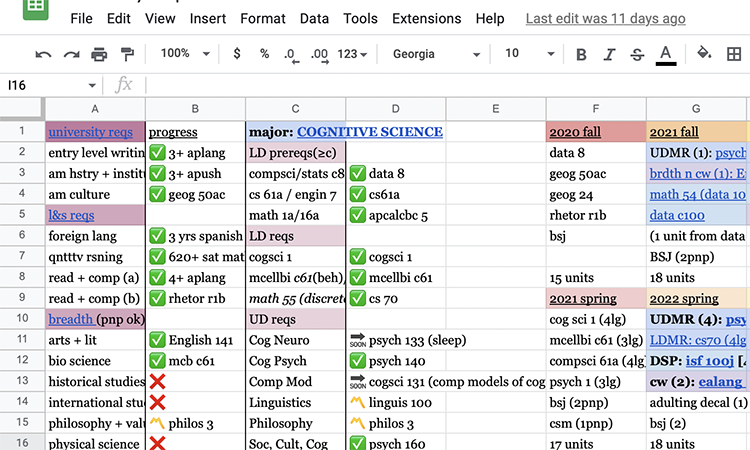
How one student finds classes he enjoys.
As a rising third-year student, I have really enjoyed my classes every semester—and a big reason why is the way I pick them. All you need are three resources which complement the foundational ones UC Berkeley offers: CalCentral, the Academic Guide, and more as described in Nolan’s article.
Along with some of my personal tips, these three resources will help you be more selective and informed about the classes you sign up for, which translates to a great time in the upcoming semester for you as well!
Rate My Professors
A valuable piece of advice I first heard from seniors and later experienced for myself is that the instructor heavily influences how you experience a class (often more so than the subject itself!). Especially if you like to learn from lectures, having an empathetic and knowledgeable professor is so impactful as they can present a complex concept in a simple and engaging way.
Personally I would use Rate My Professors (not affiliated with UC Berkeley) to understand more about the instructor of a course I am interested in. The reviews left by other students are often informative of what you may expect in terms of workload, exam style, and optimal ways to study.
However, do be mindful that the reviews are personal opinions left by students, meaning that your own experience with an instructor and class may differ from theirs. I recommend paying attention to recurring comments and ratings on the extreme end, though, especially if you are not comfortable with self-studying or the subject itself.
Berkeleytime
To see the difficulty of a class, I would search for it on Berkeleytime (a website run by UC Berkeley student volunteers) and look at the “Average Grade” section.
As my personal rule of thumb, classes that are above A- tend to be easier, while ones that are below B tend to be harder. To see the grade distribution of a class, you can click on the arrow to the right of the average grade and apply filters as desired on that new web page.
Your Academic Plan
I reference my four-year plan (or two-year if you are a transfer student) at many different points throughout my time at Berkeley, so I definitely recommend you make one if you haven’t already. I made mine using Google Sheets, but you can use any resource to list out your degree requirements and the classes you plan on taking each semester.

Sample view of Hosea’s four-year plan
Your plan keeps track of what classes you have taken, what requirements they fill, and more importantly what you plan on taking. Some classes are only offered and some professors only teach in the spring or fall (you may notice this on classes.berkeley.edu), so it’s definitely a good idea to plan ahead.
A personal tip in composing a semester’s class lineup is to make sure you have at least one class you find fun. Some students may want to cram the hard, technical classes into the first two years to “get them out of the way,” but doing so is unnecessarily stressful and could cause you to miss out on fun classes Cal has to offer along the way.
Instead, you can spread out your hard classes across semesters, and mix in a class for your art breadth, minor if you have one, or a DeCal on a topic of interest to you (I wish I did the latter sooner). Having a diversity of class subjects will ensure your motivation and curiosity are not burned out as the semester goes on.
As always, it’s a good idea to check in with a college advisor, professor, or peer tutor if you ever want their guidance.
On the Topic of Waitlists…
If you are unable to enroll in a class because it is full, most of the time it’s because the discussion (instead of the lecture) section you want is full. Therefore, you can wait for an open spot or check classes.berkeley.edu for another discussion that is open and enroll in the class that way.
There was one semester when I really wanted to take the class Social Psychology, and while I was extremely hesitant, I enrolled in an 8 a.m. discussion section to get into the class since other sections were full. Thankfully, I checked the class website a week after and found a discussion with a more merciful time to switch into.
Another valuable tip I would like to share with this anecdote is the time of a class can matter a lot: If you are not a morning person, enrolling in an 8 a.m. class sets you up for a lot of pain every week.
For what it’s worth, I’ve gotten into classes I was waitlisted for the majority of the time. Furthermore (and again as a rule of thumb), you generally get into a class if you are on the waitlist with a position within 10 percent of the class capacity; some professors even make an effort to enroll everyone, especially if the courses they teach are large and introductory.
Taking classes in college isn’t just about fulfilling your academic requirements, and you won’t feel that way as long as you pick classes and professors you are interested in and spread the hard ones out. I hope the resources and tips I shared were helpful and insightful.
Good luck and remember to have fun with your classes, Golden Bears!
Hosea Chen is a third-year at UC Berkeley majoring in cognitive science and minoring in data science and creative writing.
Want More?
- Learn about my takeaways from having a busy schedule.
- Learn about cognitively optimized study methods!
- If you’re struggling with choosing a major/minor, I did too.